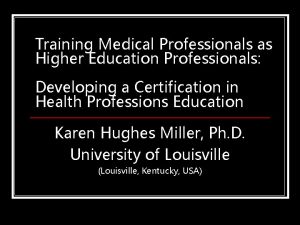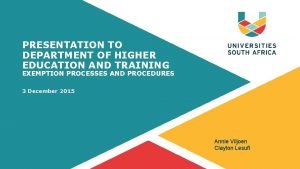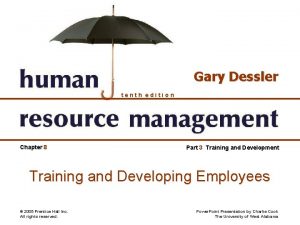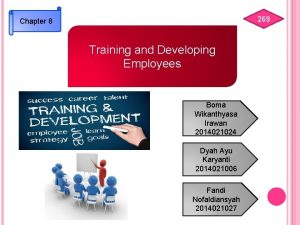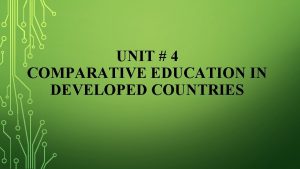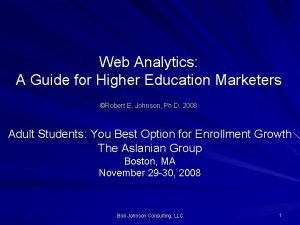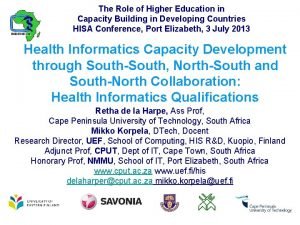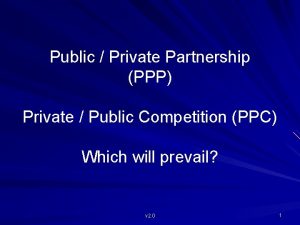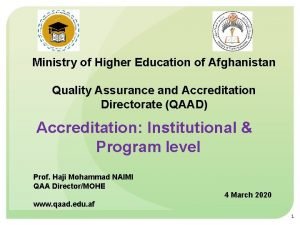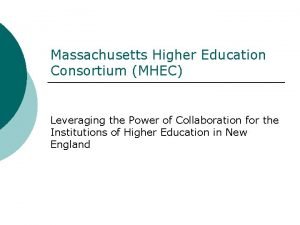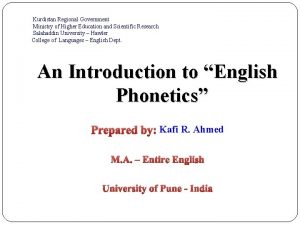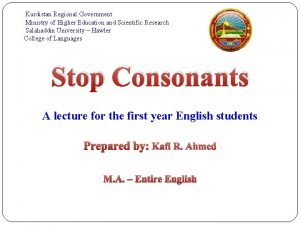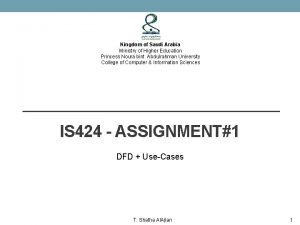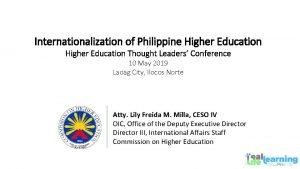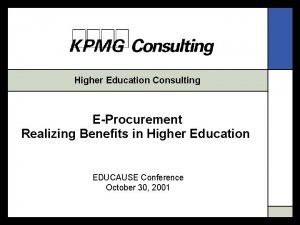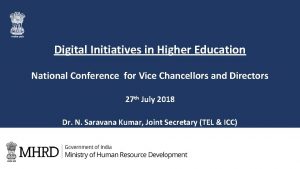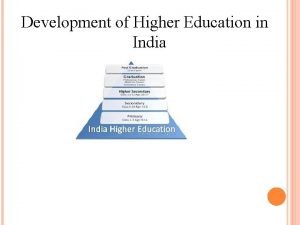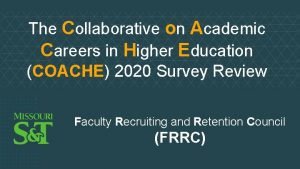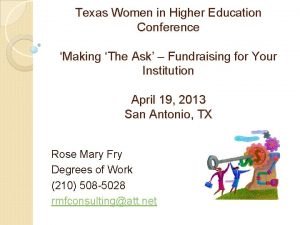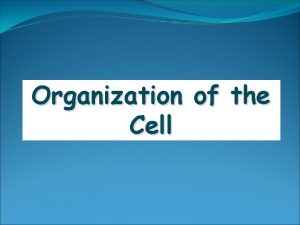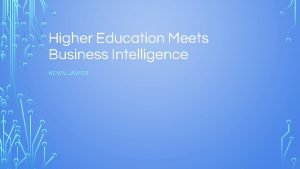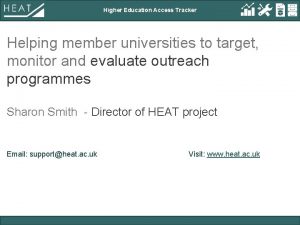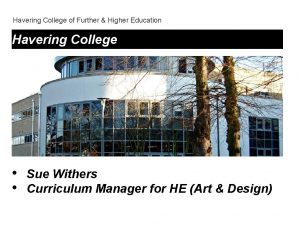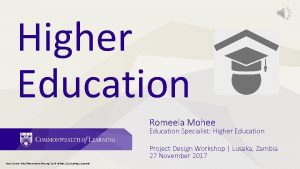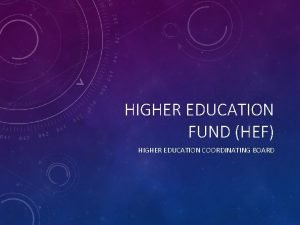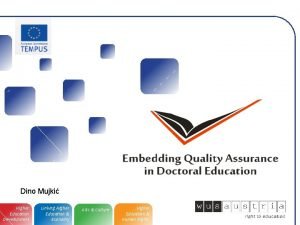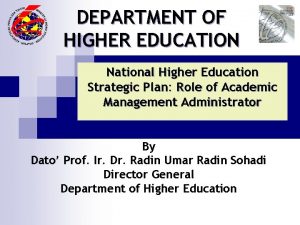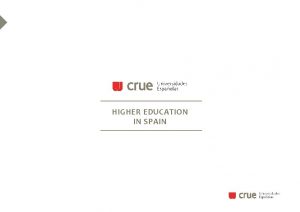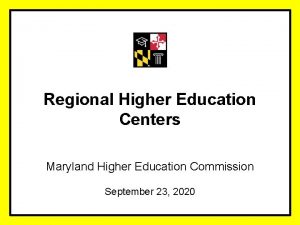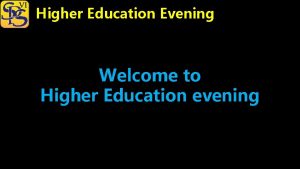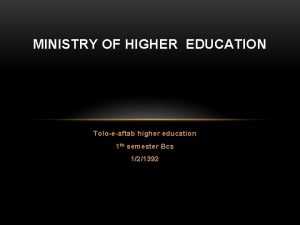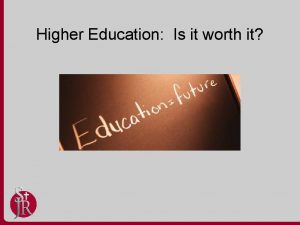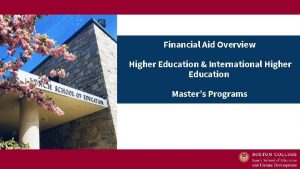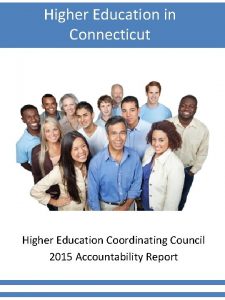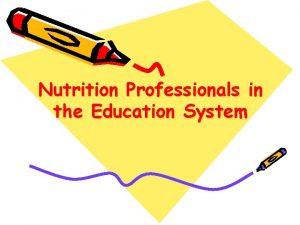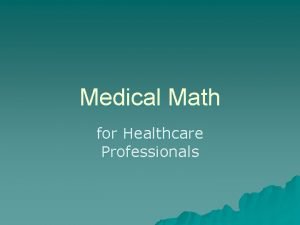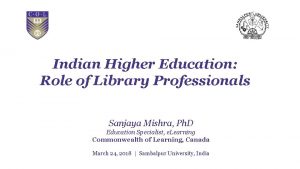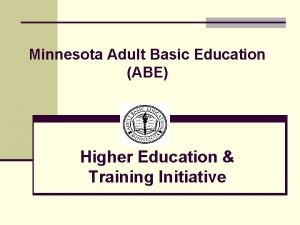Training Medical Professionals as Higher Education Professionals Developing





























- Slides: 29

Training Medical Professionals as Higher Education Professionals: Developing a Certification in Health Professions Education Karen Hughes Miller, Ph. D. University of Louisville (Louisville, Kentucky, USA)

Presented at: Collaborating Across Boarders: An American- Canadian Dialogue on Interprofessional Health Education, October 24 -26, 2007 University of Minnesota Academic Health Center Twin Cities Campus Minneapolis, Minnesota

Background: n n Physicians, nurses, and other health sciences professionals who teach often find their knowledge of teaching is learned on the job. Although professional development sessions on teaching are efficient, they may not always be an effective solution to addressing topics as complex as adult education theory or curriculum analysis.

Background: n n Medical education is growing as a recognized discipline with its own grants, publications, and conferences. For healthcare faculty to fully participate in what this discipline has to offer, they must not only be expert in their fields but also be educated in medical education (Eitel, Katz, and Tesche, 2000; and Benor, 2000).

Background: In 2003, the University of Louisville College of Education and School of Medicine Office of Medical Education joined forces to create a Certificate in Health Professions Education program. The objective of this presentation is to share our experience as a replicable model for other institutions. n

Program overview: The Certificate in Health Professions Education is awarded by the University’s Graduate School after participants complete four 3 -credit hour graduate courses. n Participants must be admitted to the Graduate School and all courses are graded and taken for academic credit. n

Program overview: n n n The curriculum allows participants to join in any term of any year rather than waiting for a two-year rotation. Each course is grounded in a syllabus already approved for the College of Education and Human Development (CEHD), but is customized for health science professionals. Courses include Research Methods, Program Evaluation and Planning, College Teaching, and Adult Education and Development.

Current program sequence: ELFH 683 College Teaching: syllabus development, teaching and assessment strategies, students’ rights, the role of research and publication in the academic arena. Fall, 2007 ELFH 661 Adult Development & Learning: basics of instructional design, principles of adult learning, and teaching in the clinical environment. Spring, 2008 ELFH 600 Research Methods: Research problem identification, research methodologies, and introductory statistics. Fall, 2008 ELFH 606 Program Evaluation and Planning: Course and program planning and validation. Spring, 2009

Customized content for HSC: Examples of customized content include: n The course on Adult Education and Development includes clinical teaching issues such as bedside teaching and the protocols of teaching using both real and simulated patients. n Techniques for teaching psychomotor skills (i. e. intubation) are included along with techniques for teaching cognitive skills such as quick recall.

Customized content for HSC: The instructional design for the four courses is grounded on the principles of meeting instructional needs for working professionals such as described by Cheetham and Chivers (2001). n Faculty and participants represent the entire range of healthcare education at U of L including medicine, nursing, dentistry, and public health. n

Customized content for HSC: n n Courses apply a blended model of online and face-to-face instruction. Class meetings are held on at the Health Sciences Campus. Teaching teams include education and health sciences faculty and guest lecturers are often used. Field trips to look at different teaching venues are built into the schedule.

Course Calendar ELFH 606 - 76 Program Evaluation and Planning Week/Session Topics Faculty/presenters Advance Readings, Class Assignments, and Tasks Week 1; January 11 Course overview and organization; introduction to program evaluation as an area of specialization; introduce the class project Dr. Muriel J. Harris Dr. Karen Hughes Miller Ms. Gail Haynes Dr. Deborah S. Armstrong Fitzpatrick, Sanders, and Worthen- Chapters 1 and 2. Introduce faculty and students; discuss student expectations from the course. Week 2; January 18 Objectives Oriented Evaluation; The U of L School of Medicine Curriculum Evaluation project (as an evaluation example). Other evaluation stakeholders – managers. Gail Haynes Karen Hughes Miller Fitzpatrick, Sanders, and Worthen- Chapters 4 and 5. Harden: the Integration Ladder: a Tool for Curriculum planning and Evaluation (article posted in Week 2 folder).

The blended learning model:

The blended learning model:

The blended learning model:

Program success: n n n The first course in the program, College Teaching, was offered in the fall of 2003. Fourteen students enrolled and 12 completed the course. The next course offered, Introduction to Research Methods, also began with 14 and ended with 12. However, we saw a “slump” in enrollment for the next course, Adult Development and Education; and by the spring of 2005, only four students enrolled in the Program Evaluation course. That group was combined with doctoral students taking the course in the College of Education.

Program revision: n n Consensus among participants and faculty was that we may have been packing too much content into the courses. While the course participants were well grounded in scientific method and physical science research, the social science research methodologies of education were new. This type of feedback was an essential component of the curriculum redesign for future courses. Courses had to be tailored to the specific needs of health science educators.

Program revision: n n n An additional strategy for encouraging certificate completion was to analyze all course rosters since the beginning of the program and contact former participants who were still at U of L. A formal letter on Office of Medical Education letterhead was sent reminding them which course(s) they needed to for certification and encouraging reenrollment. Response to this small campaign was very positive and several former participants returned in the fall 2006 or spring 2007 semesters.

Program support: n n To encourage new students to enter the program, lunchtime open house sessions are now held at the end of each semester to introduce the next course being offered and to introduce potential students to participating faculty. Over the past several semesters, these sessions have become informal get “together’s” so all sorts of questions and concerns can be addressed.

Program outcomes: n n n The Certificate in Health Professions Education at the University of Louisville is not a large project; but by using a cycle of course delivery, reflection, and refinement along with some consistent participant recruiting strategies, the program is growing. By the end of the spring 2007 semester, we had awarded 10 certificates. For the fall 2007 semester, we have seven new enrollees in the program, and eight who are active returnees.

Program outcomes: n n One unexpected positive outcome is that two Certificate participants have recently enrolled in the College of Education in order to complete Master of Education degrees to add to their M. D. s. An additional positive outcome, beginning this year, is that new faculty in Public Health are being required to take the College Teaching course. (If we do our job right, they will take the remaining courses for certification!)

Program outcomes: And the most recent positive outcome: ELFH 606 -76, Program Evaluation and Planning, won a 2007 Kentuckiana Metroversity Award for Instructional Innovation

Limitations of our model: Students in the certificate program are self selected and highly motivated. Grades in any given course are usually A or A+. This may seem intimidating to new faculty considering the program. n It is a serious commitment of time and effort for already busy healthcare professionals. They must be perceive real value for the program. n

Our three major challenges: n n n Making the course work load realistic and appropriate for working professionals while maintaining academic integrity. Retaining participants once the enter the program. Maintaining diversity among program faculty to insure an interdisciplinary approach.

Ongoing program objectives: Objective: Process: Continuous Collect and analyze assessment and course and faculty course improvement. evaluation data, review course content and design each time the course is offered.

Ongoing program objectives: Objective: Active recruitment of new participants and faculty. Recognition of the Certificate as an academic credential of value. Process: Information sessions, email and list serve, word of mouth. Publications and presentations.

References and resources: Benor, D. E. (2000). Faculty development, teacher training and teacher accreditation in medical education: twenty years from now. Medical Teacher, 22(5), 503 -512. Cheetham, G. and Chivers, G. (2001). Part I, How professionals learn: theory. Journal of European Industrial Training, 25(5), 250269. Cheetham G. and Chivers, G. (2001). Part 2, How professionals learn, the practice. What the empirical research found. Journal of European Industrial Training, 25(5), 270 - 292. Eitel, F. , Kanz, K-G. , and Tesche, A. (2000). Training and certification of teachers and trainers: The professionalization of medical education. Medical Teacher, 22(5), 517 -526.

References and resources: Miller, K. H. and Greenberg, R. (2007). Training Medical Professionals to be Educators: Developing a Certification in Health Professions Education. Journal of the International Association of Medical Science Educators (JIAMSE), special supplement, October, 2007, in press. Muller, J. H. , and Irby, D. M. Developing educational leaders: the teaching scholars program at the University of California, San Francisco, School of Medicine. Academic Medicine. 2006: 81: 11, 959 -964. Robins, L, Ambrozy, D. , and Pinsky, L. E. Promoting academic excellence through leadership development at the University of Washington: the teaching scholars program. Academic Medicine. 2006: 81: 11, 979 -983. Wilkerson, L. A. , Uijtdehaaghe, S. and Relan, A. Increasing the pool of educational leaders for UCLA. Academic Medicine. 2006: 81: 11, 954 -958.

A closing note…. In addition to articles on the UCLA, UC San Francisco, and University of Washington models, the November 2006 issue of Academic Medicine includes several more articles on medical education fellowships.
 Training for higher education professionals
Training for higher education professionals Department of higher education and training
Department of higher education and training Allied health professions list
Allied health professions list Chapter 8 training and developing employees
Chapter 8 training and developing employees Chapter 8 training and developing employees
Chapter 8 training and developing employees Unit 4 school education system
Unit 4 school education system Web analytics in higher education
Web analytics in higher education Capacity building in the field of higher education
Capacity building in the field of higher education Importance of faculty in higher education
Importance of faculty in higher education Rhode island board of governors for higher education
Rhode island board of governors for higher education Ppc for higher education
Ppc for higher education Ministry of higher education (afghanistan)
Ministry of higher education (afghanistan) Massachusetts higher education consortium
Massachusetts higher education consortium Ministry of education kurdistan
Ministry of education kurdistan Ministry of higher education kurdistan
Ministry of higher education kurdistan Kurdistan higher education
Kurdistan higher education Ministry of higher education saudi arabia
Ministry of higher education saudi arabia Internationalization of higher education in the philippines
Internationalization of higher education in the philippines Higher education eprocurement
Higher education eprocurement Digital initiatives in higher education
Digital initiatives in higher education Gartner digital transformation in higher education
Gartner digital transformation in higher education Development of higher education in india
Development of higher education in india Learning without burden yashpal committee report
Learning without burden yashpal committee report Collaborative on academic careers in higher education
Collaborative on academic careers in higher education Texas women in higher education
Texas women in higher education 2007 thomson higher education
2007 thomson higher education Higher education achievement report
Higher education achievement report Education meets business
Education meets business Higher education access tracker
Higher education access tracker Havering college of further and higher education
Havering college of further and higher education
